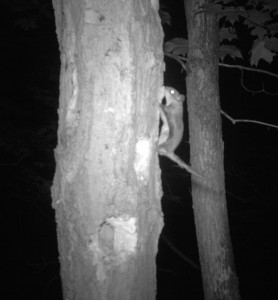Flying Squirrels—Nocturnal Aviators
Upcoming MVFN Lecture: Thursday, November 17, 2011
The Mississippi Valley Field Naturalists’ (MVFN) public lecture series, Trends in Fauna and Flora, continues November 17 with the third presentation, “Flying Squirrels—Nocturnal Aviators.” You do not need to be an expert to enjoy the presentations—just possess a curiosity or appreciation for wild nature. Cottagers, hunters, fishermen, canoeists, hikers, campers, artists and seasoned field naturalists alike will find something to interest them as we explore what lives in Lanark County and how best to protect it for future generations. Refreshments are offered at each lecture.
This month’s lecture will be presented by Dr. Jeff Bowman from the Ontario Ministry of Natural Resources and also an adjunct professor at Trent University. He has studied flying squirrel ecology in Ontario for years, looking at genetics, habitats, boundary dynamics, population density, and landscape patchworks. Dr. Bowman’s presentation will give us an opportunity to become familiar with these rarely seen relatives of the familiar chipmunk, red squirrel, and grey squirrel.
There are over 40 species of flying squirrels in the world, including the Asian giant flying squirrels, woolly flying squirrels (Pakistan), Winston Churchill’s flying squirrel (Sumatra), dwarf and hairy-footed flying squirrels (southeast Asia), complex-toothed flying squirrel (China), and pygmy flying squirrels (Malaysia). Just two species are found in North America—the northern and southern flying squirrel. Both species are thought to have migrated to our continent across the Bering land bridge, but at different times. The evidence lies in the nature of the baculum (a small bone that supports the penis and facilitates mating). The baculum of the northern flying squirrel is structurally much closer to that of an Asian genus of flying squirrels than to that of the southern flying squirrel.
Northern flying squirrels typically are found in coniferous or mixed forests, while the southern flying squirrel occurs in deciduous and mixed forests. Both species rely on cavities in large trees and are sensitive to forest fragmentation. Thus they are used as indicator species of forest habitat quality in many regions of North America.
Lanark County is home to both kinds of flying squirrels, which are active only at night. Have you ever seen a flying squirrel? In the winter months, I often see them at my bird feeder. A violently-rocking feeder on a still winter night is the tip-off. Closer inspection reveals a pair of flying squirrels which appear to be in constant motion, darting from tree to feeder and back again, their large eyes glowing in the house lights.
So how can you tell these two squirrels apart? Southern individuals have a smaller body size than a chipmunk, while the northern ones are larger than this striped relative. Southern flying squirrels (20 to 25 cm long) have grey brown fur on top with darker flanks and are a cream color underneath. Northern flying squirrels (25 to 37 cm long) have light brown or cinnamon fur above with greyish flanks and are whitish underneath. Still not sure? Come to the lecture and see them up close.
Flying squirrels are fascinating. Depending on the wind and takeoff height, they can glide for 50 metres or more. A skin membrane, called the patagium, is stretched between their relatively long front and rear legs, allowing them to sail from tree to tree. While airborne, they can change direction with the use of their long, flat tail. These arboreal squirrels have sharp, curved claws and hind feet that can rotate 180 degrees while descending a tree. Their large eyes and long whiskers are typical of nocturnal mammals. Flying squirrels often share nests. While a nest typically houses 2-5 individuals, over 50 have been found co-habiting! Nest-sharing is important for conserving energy and maintaining body temperature in the winter, as flying squirrels do not hibernate.
Many species have responded to modern climate change through shifts in their geographic range. A recent study showed that southern flying squirrels in Ontario rapidly expanded their northern range limit in response to warmer winters. This resulted in more overlap with the range of the northern flying squirrel. Not only that, but where they co-occurred, the species interbred and created fertile offspring! This was the first report of hybridization between North American flying squirrel species.
Go squirrelly and learn more about the habits, habitats, and conservation of these dynamic, flightly small mammals. Ponder their response to climate change at Dr. Bowman’s presentation “Flying Squirrels—Nocturnal Aviators” at 7:30p.m. on Thurs. Nov. 17, 2011, Almonte United Church, 106 Elgin St., Almonte. All are welcome ($5 fee for non-members). For further information please contact MVFN’s Program Chair, Cathy Keddy at 631-257-3089.
__________________________________________________









